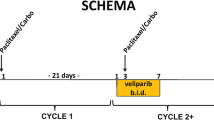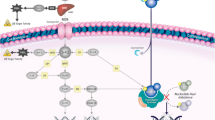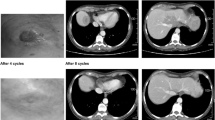Summary
Background TAS-106 is a novel nucleoside analog that inhibits RNA polymerases I, II and II and has demonstrated robust antitumor activity in a wide range of models of human cancer in preclinical studies. This study was performed to principally evaluate the feasibility of administering TAS-106 as a bolus intravenous (IV) infusion every 3 weeks. Patients and Methods Patients with advanced solid malignancies were treated with escalating doses of TAS-106 as a single bolus IV infusion every 3 weeks. Plasma and urine sampling were performed during the first course to characterize the pharmacokinetic profile of TAS-106 and assess pharmacodynamic relationships. Results Thirty patients were treated with 66 courses of TAS-106 at eight dose levels ranging from 0.67–9.46 mg/m2. A cumulative sensory peripheral neuropathy was the principal dose-limiting toxicity (DLT) of TAS-106 at the 6.31 mg/m2 dose level, which was determined to be the maximum tolerated dose (MTD). Other mild-moderate drug-related toxicities include asthenia, anorexia, nausea, vomiting, myelosuppression, and dermatologic effects. Major objective antitumor responses were not observed. The pharmacokinetics of TAS-106 were dose-proportional. The terminal elimination half-life (t1/2) averaged 11.3 ± 3.3 h. Approximately 71% of TAS-106 was excreted in the urine as unchanged drug. Pharmacodynamic relationships were observed between neuropathy and: C5min; AUC0-inf; and dermatologic toxicity. Conclusions The recommended phase II dose of TAS-106 is 4.21 mg/m2. However, due to a cumulative drug-related peripheral sensory neuropathy that proved to be dose-limiting, further evaluation of this bolus every 21 day infusion schedule will not be pursued and instead, an alternate dosing schedule of TAS-106 administered as a continuous 24-hour infusion will be explored to decrease Cmax in efforts to minimize peripheral neuropathy and maximize antitumor activity.



Similar content being viewed by others
References
Schiller G, Gajewski J, Territo M et al (1992) Long-term outcome of high-dose cytarabine-based consolidation chemotherapy for adults with acute myelogenous leukemia. Blood 80:2977–2982
Yates J, Gildwell O, Wiernik P et al (1982) Cytosine arabinoside with daunorubicin or adriamycin for therapy of acute myelocytic leukemia: a CALGB study. Blood 60:454–462
Sandler AB, Nemunaitis J, Denham C et al (2000) Phase III trial of gemcitabine plus cisplatin versus cisplatin alone in patients with locally advanced or metastatic non-small-cell lung cancer. J Clin Oncol 18:122–130
Burris HA, Moore MJ, Andersen J et al (1997) Improvements in survival and clinical benefit with gemcitabine as first-line therapy for patients with advanced pancreas cancer: a randomized trial. J Clin Oncol 15:2403–2413
Ohno Y, Spriggs D, Matsukage A, Ohno T, Kufe D (1988) Effects of 1-β-D-arabinofuranosylcytosine incorporation on elongation of specific DNA sequences by DNA polymerase β. Cancer Res 48:1494–1498
Mikita T, Beardsley GP (1988) Functional consequences of the arabinosylcytosine structural lesion in DNA. Biochemistry 27:4698–4705
Fram RJ, Kufe DW (1982) DNA strand breaks caused by inhibitors of DNA synthesis: 1-β-D-arabinofuranosylcytosine and aphidicolin. Cancer Res 42:4050–4053
Ross DD, Cuddy DP, Cohen N, Hensley DR (1992) Mechanistic implications of alterations in HL-60 cell nascent DNA after exposure to 1-β-D-arabinofuranosylcytosine. Cancer Chemother Pharmacol 31:61–70
Ruiz van Haperen VWT, Veerman G, Vermorken JB, Peters GF (1993) 2′, 2′-difluorodeoxycytidine (gemcitabine) incorporation into RNA and DNA of tumor cell lines. Biochem Pharmacol 46:762–766
Carmichael J, Possinger K, Phillip P (1995) Advanced breast cancer: a phase II trial with gemcitabine. J Clin Oncol 13:2731–2736
Pollera CF, Ceribelli A, Crecco M, Calabresi F (1994) Weekly gemcitabine in advanced bladder cancer: a preliminary report from a phase I study. Ann Oncol 5:182–184
Tabata S, Tanaka M, Matsuda A, Fukushima M, Sasaki T (1996) Antitumor effect of a novel multifunctional antitumor nucleoside, 3′-ethynylcytidine, on human cancers. Oncol Rep 3:1029–1034
Fukushima M (1998) The new antitumor ribonucleoside 3′-C-ethynylcytidine: Its antitumor effects and mechanism of action. Purine Pyrimidine Metab 22:189–199
Mattern MR, Fecteau DA, Sung CM, Fisher PW, Johnson RK, Winkler JD (200) Ecyd is an inhibitor of RNA polymerase which induces apoptosis without activation of the DNA damage checkpoint. Clin Cancer Res 6:4554s,440a.
Azuma A, Emura T, Huang P, Plunkett W (1999) Intracellular metabolism and actions of a novel antitumor nucleoside, 1-(3′-C-ethynyl-β-D-ribo-pentofuranosyl) cytosine (Ecyd, TAS-106). Proc Am. Assoc Cancer Res 40:298,1975a
Takatori S, Kanda H, Takenaka K (2000) Antitumor mechanisms and metabolism of the novel antitumor nucleoside analogues, 1-(3-C-ethynyl-β-D-ribo-pentofuranosyl)uracil. Cancer Chemother Pharmacol 44:97–104
Hattori H, Tanaka M, Fukushima M, Sasaki T, Matsuda A (1996) Nucleosides and Nucleotides. 1-(3-C-ethynyl-b-D-ribo-pentofuranosyl)-cytosine, 1-(3-C-ethynyl-β-D-ribo-pentofuranosyl)uracil, and their nucleobase analgoues as new potential multifunctional antitumor nucleosides with a broad spectrum of activity. J Med Chem 39:5005–5011
Tsuji A, Tami I, Saheki A (1999) Facilitative transport of antitumor nucleosides, 3′-ethynylcytidine (ECyd, TAS-106) and 3′-ethynyluridine (EUrd). Proc Am Assoc Cancer Res 40:298, 1977a
Tanaka M, Sasaki T (2000) Cellular uridine/cytidine kinsae (U/C kinase) as a promising predictor of a novel nucleoside 3′-ethynylcytidine sensitivity. Proc NCI-EORTC-AACR 11:4554S, 441a
TAS-106 Investigator Brochure. Tokyo, Japan. Taiho Pharmaceutical Co., Ltd. 2001
Shimamoto Y, Murukami Y, Kazuno H et al (1999) Effect of the TAS-106 (3′-C-ethynylcytidine, ECyd) dosage schedule on antitumor efficacy in experimental human cancer. Proc Am Assoc Cancer Res 40:298,1979a
Zubrod CG, Schneiderman M, Frei E (1960) Appraisal methods for the study of chemotherapy of cancer in man: comparative therapeutic trials of nitrogen mustard and triethylene thiophosphoramide. J Chron Dis 11:7–33
Guidelines for Reporting of Adverse Drug Reactions, Division of Cancer Treatment, National Cancer Institute. Bethesda, MD: National Cancer Institute, 1988
Matsuoka K, Kitamura R, Matsushima E, Kawaguchi Y (2003) Determination of 3′-C-ethynylcytidine in human plasma and urine by liquid chromatographic-electroscopy ionization tandem mass spectrometry. J Pharm Biomed Anal 31:47–55
Hashimoto T (2001) Statistical evaluation of pharmacokinetics linearity in clinical pharmacological study. Xenobio Metabol Dispos 16:244–252
Estey EH, Thall PF, Pierce S et al (1999) Randomized phase II study of fludarabine + cytosine arabinoside + idarubicin +/− all-trans retinoic acid +/− granulocyte colony-stimulating factor in poor prognosis newly diagnosed acute myeloid leukemia and myelodysplastic syndrome. Blood 93:2478–2484
Burnett AK (1999) Tailoring the treatment of acute myeloid leukemia. Curr Opin Hematol 6:247–252
McCarthy AJ, Pitcher LA, Hann IM, Oakhill A (1999) FLAG (fludarabine, high-dose cytarabine, and G-CSF) for refractory and high-risk relapsed acute leukemia in children. Med Pediatr Oncol 32:411–415
Lund B, Ryberg M, Petersen P, Anderson H, Thatcher N, Dombernowsky P (1994) Phase II study of gemcitabine (2′, 2′-difluorodeoxycytidine) given as a twice weekly schedule to previously untreated patients with non-small cell lung cancer. Ann Oncol 5:852–853
Abratt RP, Bezwoda WR, Falkson G, Goedhals L, Hacking D, Rugg TA (1994) Efficacy and safety profile of gemcitabine in non-small cell lung cancer: a Phase II study. J Clin Oncol 12:1535–1540
Anderson H, Lund B, Bach F, Thatcher N, Walling J, Hansen HH (1994) Single-agent activity of weekly gemcitabine in advanced non-small-cell lung cancer: a Phase II study. J Clin Oncol 12:1821–1826
Lund B, Hansen OP, Theilade K, Hansen M, Neijt JP (1994) Phase II study of gemcitabine (2′, 2′-difluorodeoxycytidine) in previously treated ovarian cancer patients. J Natl Cancer Inst 86:1530–1533
Jeha S, Razzouk B, Gaynon P (2004) Clofarabine therapy for the treatment of relapsed or refractory pediatric acute leukemias. Proc Am Soc Clin Oncol 23:796,8504a
Russell JA, Powles RL (1974) Neuropathy due to cytosine arabinoside. Br Med J 4:652–653
Borgeat A, DeMuralt B, Stalder M (1986) Peripheral neuropathy associated with high-dose Ara-C therapy. Cancer 58:852–854
Thomas M, Mita A, Hammond L, et al (2002) A phase I and pharmacokinetic study of TAS-106 administered weekly for 3 consecutive weeks every 28 days in patients with solid tumors. Eur J Cancer 38:S25,67a
Cho ES, Spencer PS, Jortner BS, Schaumburg HH (1980) A single intravenous injection of doxorubicin (Adriamycin) induces sensory neuropathy in rats. NeuroToxicology 1:583–591
Cho ES (1977) Toxic effects of Adriamycin on the ganglia of the peripheral nervous system: a neuropathological study. J Neuropathol Exp Neurol 36:907–915
Anthony DC, Montine TJ, Graham DG (1997) Toxic responses of the nervous system, neuronopathies, casarett and doull’s toxicology. In: Klaassen CD (ed) The basic science of poisons, 5th edn, pp 467–470
Megumi T et al (1977) Drug induced sensory impairment: mode of peripheral neuropathy that is based on the site of primary impairment in the lesions. Brain and Neuroscience Drug Induced Neuropathy 5:98–102
Smith B (1969) Damage to the intrinsic cardiac neurones by rubidomycin (daunorubicin). Br Heart J 31:607–609
de Bono JS, Stephenson J Jr, Baker SD et al (2002) Troxacitabine, an L-steroisomeric nucleoside analog, on a five-times-daily schedule: a phase I and pharmacokinetic study in patients with advanced solid malignancies. J Clin Oncol 20:96–109
Giles GJ, Cortes JE, Baker SD et al (2001) Troxacitabine, a novel dioxolane nucleoside analog, has activity in patients with advanced leukemia. J Clin Oncol 19:762–771
Townsley CA, Chi K, Ernst DS et al (2003) Phase II study of troxacitabine (BCH-4556) in patients with advanced and/or metastatic renal cell carcinoma: a trial of the National Cancer Institute of Canada-Clinical Trials Group. J Clin Oncol 21:1524–1529
Dent SF, Arnold A, Stewart D, et al (2001) Phase II study of troxacitabine (BCH-4556) in patients with advanced non-small cell lung cancer (NSCLC). Proc Am Soc Clin Oncol 20:259b, 2768a
Belanger K, Moore M, Baker SD et al (2002) Phase I and pharmacokinetic study of a novel L-nucleoside analog troxacitabine given as a 30-minute infusion every 21 days. J Clin Oncol 20:2567–2574
Meyers CA, Byrne KS, Komaki R (1995) Cognitive deficits in patients with small cell lung cancer before and after chemotherapy. Lung Cancer 12:231–235
van Dam FSAM, Schagen SB, Muller MJ et al (1998) Impairment of cognitive function in women receiving adjuvant treatment for high-risk breast cancer: high-dose versus standard-dose chemotherapy. J Natl Cancer Inst 90:210–218
Pavol M, Meyers CA, Rexer JL, Valentine AD, Mattis PJ, Talpaz M (1995) Pattern of neurobehavioral deficits associated with interferon-alfa therapy for leukemia. Neurology 45:947–950
Capizzi RL, Yang JL, Cheng E et al (1983) Alterations of the pharmacokinetics of high-dose ara-C by its metabolite, high ara-U in patients with acute leukemia. J Clin Oncol 1:763–771
Plunkett W, Huang P, Searcy CE et al (1996) Gemcitabine: Preclinical pharmacology and mechanisms of action. Semin Oncol 23:S3–S15
Disclosure of potential conflicts of interest
Hitoshi Matsushita and Akira Mita are employees of Taiho Pharmaceuticals. The other authors declare no potential conflicts of interest.
Grant support
This investigators received funding for this study by Taiho Pharmaceuticals.
Author information
Authors and Affiliations
Corresponding author
Rights and permissions
About this article
Cite this article
Hammond-Thelin, L.A., Thomas, M.B., Iwasaki, M. et al. Phase I and pharmacokinetic study of 3′-C-ethynylcytidine (TAS-106), an inhibitor of RNA polymerase I, II and III,in patients with advanced solid malignancies. Invest New Drugs 30, 316–326 (2012). https://doi.org/10.1007/s10637-010-9535-y
Received:
Accepted:
Published:
Issue Date:
DOI: https://doi.org/10.1007/s10637-010-9535-y




